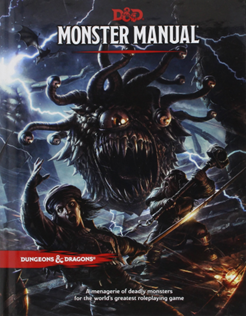 Over the years, Dungeons & Dragons adventures have tried many different techniques of presenting monster stats in the adventure. The first adventures – Steading of the Hill Giant Chief – listed the hit points of the monsters and then expected you to look them up in the Monster Manual. Later AD&D products provided “full” stat-blocks, although they’d typically leave out special ability descriptions. However, as most common monsters didn’t have them, this wasn’t significant. With 3E, the stat-blocks and monster abilities became a lot more complicated and including monster stats in the text of the adventure made it more difficult to comprehend the adventure.
Over the years, Dungeons & Dragons adventures have tried many different techniques of presenting monster stats in the adventure. The first adventures – Steading of the Hill Giant Chief – listed the hit points of the monsters and then expected you to look them up in the Monster Manual. Later AD&D products provided “full” stat-blocks, although they’d typically leave out special ability descriptions. However, as most common monsters didn’t have them, this wasn’t significant. With 3E, the stat-blocks and monster abilities became a lot more complicated and including monster stats in the text of the adventure made it more difficult to comprehend the adventure.
If you want to present the monster stat-blocks in the adventure text, I suggest these guidelines:
- Encounters should not go longer than two pages. Most should not exceed one page.
- Monster statistics should not break over a page turn. In a printed book layout, having a stat-block breaking over two facing pages is fine. In a PDF, it’s not good to break over two pages.
- Monster statistics should be repeated in full each time they appear. Do NOT have a stat-block and then reference it later in the book with a “see page 8”. At that point, you should have used an appendix.
If you want to present the monster stat-blocks in an appendix, I suggest:
- Monster descriptions in the appendix should be presented alphabetically, not sorted by encounter. (Sorting by encounter causes problems if you repeat monsters, and it makes it difficult to find them).
- Monster statistics should not break over a page turn. In a book layout, having a stat-block breaking over two facing pages is fine. In a PDF, it’s not good to break over two pages. (Yes, this is the same as the point in the section above).
- Include all monsters unique to your adventure and any monsters from a source that is not the Monster Manual. You can assume everyone has the Monster Manual; you can’t assume any other non-core book. (Keep in mind the legalities of using monsters as well; there are different rules for using them on the DMs Guild or in an OGL product).
- If you are writing an Organised Play adventure, include all monsters from the Monster Manual as well.
- If you are not writing an Organised Play adventure, only include monsters from the Monster Manual if there are no more than 5 or 6 of them.
- Monster names in the adventure text should be in bold text, the same way as in official D&D adventures. Following a standard format significantly helps DMs understand the adventure.
I also note that including many types of monsters in an encounter is very tricky for a DM to handle. In general, you shouldn’t use more than three monster types in a single encounter. Rare encounters can go to four monster types, and in those cases, I’d try to make most of the monsters relatively simple as far as their special abilities go.
My preference is to put monster statistics in the appendix and not to include Monster Manual creatures.
